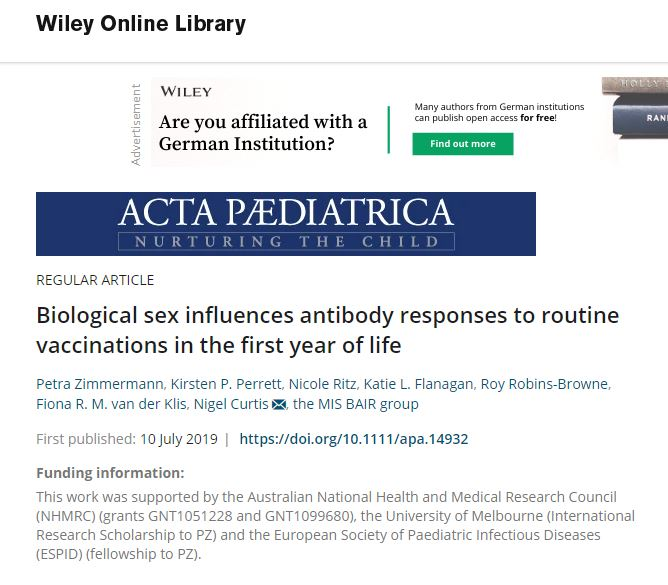Biological sex influences antibody responses to routine vaccinations in the first year of life.
We investigated the effect of early-life factors, namely sex, delivery mode, feeding method and antibiotic exposure, on antibody responses to routine vaccinations administered during the first year of life. One and seven months after the primary course of routine vaccines and 1 month after routine vaccines at 12 months of age, antibodies against 26 vaccine antigens were measured in 398 healthy infants. The geometric mean concentration (GMC) of antibodies (adjusted for effect modifiers with multiple linear regression) and the seroprotection rate for each vaccine were compared for each early-life factor. Sex had an influence on GMCs. Antibody concentrations were significantly lower at 7 months of age in females for tetanus and filamentous haemagglutinin and at 13 months of age for pertactin. In contrast, at 13 months of age, antibody concentrations were significantly higher in females for polio type 3, pneumococcal serotype 6A and measles. Sex did not have an influence on seroprotection rates. Delivery mode, feeding method and antibiotic exposure did not exert a substantial influence on vaccine antibody concentrations. There is a difference between males and females in the humoral response to routine vaccinations in the first year of life.
Authors
Petra Zimmermann; Kirsten P Perrett; Nicole Ritz; Katie L Flanagan; Roy Robins-Browne; Fiona R M van der Klis; Nigel Curtis
External link
Publication Year
Publication Journal
Associeted Project
Microbiology or Immunology
Lista de serviços
-
RASL11A, member of a novel small monomeric GTPase gene family, is down-regulated in prostate tumors.RASL11A, member of a novel small monomeric GTPase gene family, is down-regulated in prostate tumors.
-
Splice variants of TLE family genes and up-regulation of a TLE3 isoform in prostate tumors.Splice variants of TLE family genes and up-regulation of a TLE3 isoform in prostate tumors.
-
Concepts on Microarray Design for Genome and Transcriptome AnalysesConcepts on Microarray Design for Genome and Transcriptome Analyses
-
The iron stimulon of Xylella fastidiosa includes genes for type IV pilus and colicin V-like bacteriocins.The iron stimulon of Xylella fastidiosa includes genes for type IV pilus and colicin V-like bacteriocins.
-
Origins of the Xylella fastidiosa prophage-like regions and their impact in genome differentiation.Origins of the Xylella fastidiosa prophage-like regions and their impact in genome differentiation.
-
The role of prophage in plant-pathogenic bacteria.The role of prophage in plant-pathogenic bacteria.
-
Genetic control of immune response and susceptibility to infectious diseases.Genetic control of immune response and susceptibility to infectious diseases.
-
Building capacity for advances in tuberculosis research; proceedings of the third RePORT international meeting.Building capacity for advances in tuberculosis research; proceedings of the third RePORT international meeting.
-
São Paulo School of Advanced Sciences on Vaccines: an overview.São Paulo School of Advanced Sciences on Vaccines: an overview.
-
A reasonable request for true data sharing.A reasonable request for true data sharing.

